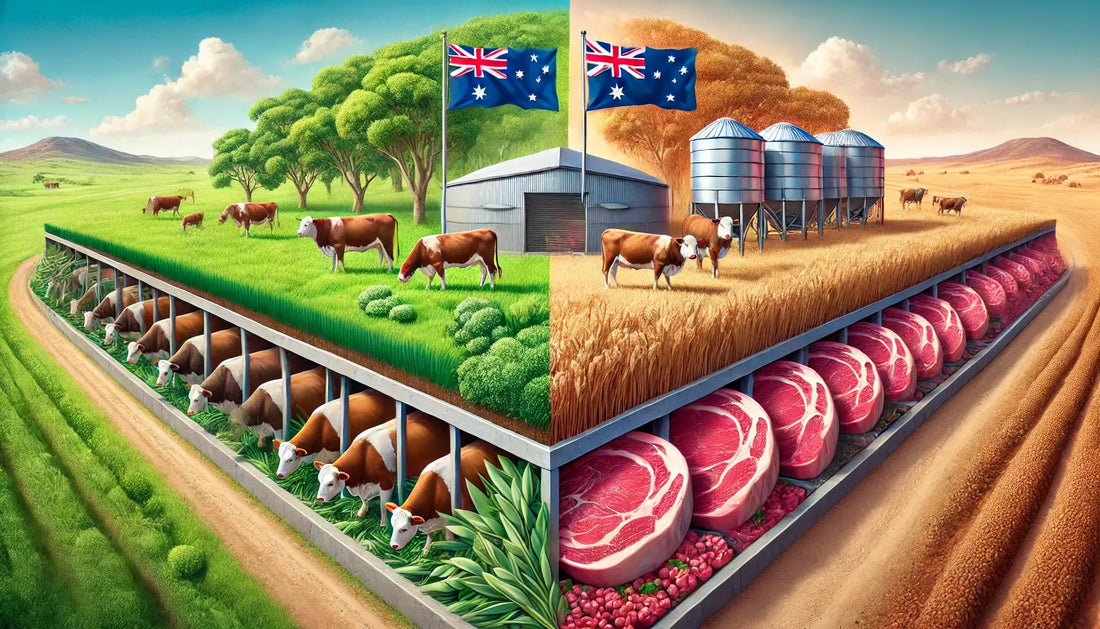
Grass-Fed vs. Grain-Fed Beef: Exploring the Differences in Australian Beef
Share
When it comes to beef, there are two main types that have gained significant attention in recent years: grass-fed beef and grain-fed beef. As an Australian, you may have noticed the growing popularity of these different beef varieties on supermarket shelves and in restaurants. But what exactly sets them apart? In this blog post, we'll dive into the key differences between grass-fed and grain-fed beef, particularly the 100 days plus grain-fed variety, and help you understand which one might be the better choice for your culinary needs.
Grass-Fed Beef: The Natural Approach
Grass-fed beef is exactly what it sounds like – beef from cattle that have been raised on a diet of grass and other forage throughout their entire lives. This natural approach to raising cattle allows them to graze freely and consume the nutrients they would naturally find in their environment. The result is a beef that is often leaner, with a more robust and earthy flavor profile.
Nutritional Profile
Grass-fed beef is generally considered to be more nutritious than its grain-fed counterpart. It tends to be higher in omega-3 fatty acids, conjugated linoleic acid (CLA), and certain vitamins and minerals, such as vitamin E and beta-carotene. These nutrients are believed to have various health benefits, including improved heart health and reduced inflammation.
Flavor and Texture
The grass-fed diet also imparts a unique flavor to the beef. Grass-fed beef is often described as having a more intense, "beefier" taste, with a slightly gamier note. The texture can also be a bit firmer and chewier compared to grain-fed beef.
Environmental Impact
One of the key advantages of grass-fed beef is its lower environmental impact. Cattle that graze on pastures and consume a natural diet contribute less to greenhouse gas emissions and require fewer resources, such as water and land, compared to their grain-fed counterparts.
Grain-Fed Beef (100 Days Plus): The Intensive Approach
In contrast to grass-fed beef, grain-fed beef is produced by cattle that are primarily fed a diet of grains, such as corn and soy, for a significant portion of their lives. This intensive feeding method is often used to fatten the cattle and increase the marbling of the meat, which can result in a more tender and juicy texture.
Nutritional Profile
Grain-fed beef tends to be higher in saturated fat and lower in omega-3 fatty acids and certain vitamins and minerals compared to grass-fed beef. However, the 100 days plus grain-fed variety is often more consistent in its nutritional profile, as the cattle have been on a controlled diet for a longer period.
Flavor and Texture
The grain-based diet of 100 days plus grain-fed beef results in a more mild and buttery flavor profile, with a softer and more tender texture. This makes it a popular choice for many consumers who prefer a more delicate and less intense beef experience.
Environmental Impact
The environmental impact of grain-fed beef is generally higher than that of grass-fed beef. The production of grains, such as corn and soy, requires significant resources, including water, land, and energy, and can contribute to soil depletion and other environmental concerns.
Comparing Grass-Fed and Grain-Fed Beef
When it comes to the differences between grass-fed and grain-fed beef, the key factors to consider are nutrition, flavor and texture, and environmental impact.
Nutritional Differences
Grass-fed beef is generally considered to be the more nutritious option, with higher levels of omega-3 fatty acids, CLA, and certain vitamins and minerals. However, the 100 days plus grain-fed variety is more consistent in its nutritional profile, making it a viable choice for those seeking a more predictable nutritional experience.
Flavor and Texture Differences
Grass-fed beef has a more intense, earthy flavor and a firmer texture, while grain-fed beef (100 days plus) is known for its more mild, buttery flavor and softer, more tender texture. The choice between the two will largely depend on personal preference and the desired culinary experience.
Environmental Impact Differences
Grass-fed beef has a lower environmental impact, as the cattle are able to graze on pastures and consume a more natural diet. Grain-fed beef, on the other hand, requires the production of large quantities of grains, which can have a more significant environmental footprint.
Conclusion: Choosing the Right Beef for You
When it comes to choosing between grass-fed and grain-fed beef, there is no one-size-fits-all answer. It ultimately comes down to your personal preferences, dietary needs, and environmental concerns.
If you prioritize nutrition and a more sustainable approach, grass-fed beef may be the better choice. However, if you prefer a more consistent and delicate flavor profile, the 100 days plus grain-fed variety might be the way to go.
Ultimately, the decision is yours. Experiment with both types of beef and see which one best suit your culinary preferences and aligns with your values. Whichever you choose, you can be sure that you're enjoying a high-quality and delicious Australian beef experience.
